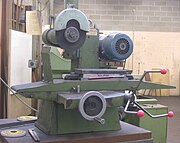 Turned chess pieces |
Metalworking is the craft and practice of working with metals to create parts or structures. The term covers a wide range of work-from large ships, bridges and oil refineries to delicate jewellery. It therefore includes a correspondingly wide range of skills and the use of many different types of tools.
Milling

A manual milling machine with digital readouts
Milling is generally done on a milling machine, which is a power-driven machine used for the complex shaping of metal (or possibly other materials) parts, by removing unneeded material to form the final shape. Its basic form is that of a milling cutter that rotates about the spindle axis (like a drill), and a worktable that can move in multiple directions (usually three dimensions [x,y,z axis] relative to the workpiece, whereas a drill can only move in one dimension [z axis] while cutting). The motion across the surface of the workpiece is usually accomplished by moving the table on which the workpiece is mounted, in the x and y directions. Milling machines may be operated manually or under computer numerical control (CNC), and can perform a vast number of complex operations, such as slot cutting, planing, drilling and threading, rebating, routing, etc.
Turning
 Conventional metalworking lathe |
A lathe is a machine tool which spins a block of material so that when abrasive, cutting, or deformation tools are applied to the workpiece, it can be shaped to produce an object which has rotational symmetry about an axis of rotation. Examples of objects that can be produced on a lathe include candlestick holders, table legs, bowls, baseball bats, crankshafts or camshafts.
The material may be held in place by a chuck or worked between one or two centers of which at least one can be moved horizontally to accommodate varying material lengths. In a metalworking lathe, metal is removed from the workpiece using a hardened cutting tool which is usually fixed to a solid moveable mounting called the "toolpost", this arrangement is then moved around the workpiece using handwheels and/or computer controlled motors.
Marking out

A combination square used for transferring designs.
Marking out is the process of transferring a design or pattern to a workpiece and is the first step in the handcraft of metalworking. It is performed in many industries or hobbies, although in the repetition industries the need to mark out every individual piece is eliminated.
In the metal trades area, marking out consists of transferring the engineers plan to the workpiece in preparation for the next step, machining or manufacture.
Drilling and threading
 Three different types and sizes of taps |
Drilling is the process of using a drill bit in a drill to produce holes. Under normal usage, swarf is carried up and away from the tip of the drill bit by the fluting. The continued production of chips from the cutting edges pushes the older chips outwards from the hole. This continues until the chips pack too tightly, either because of deeper than normal holes or insufficient backing off (removing the drill slightly [breaking the chip] or totally from the hole [clearing the bit] while drilling). Lubricants (or coolants) (i.e. cutting fluid) are sometimes used to ease this problem and to prolong the tools life by cooling, lubricating the tip and improving chip flow.
Taps and dies are tools commonly used for the cutting of screw threads in metal parts. A tap is used to cut a female thread on the inside surface of a predrilled hole, while a die cuts a male thread on a preformed cylindrical rod.
Die head | Drill | Drill bit | Drill bit shank | Drill bit sizes | Drilling| Pin chuck| Taps and dies | Tap wrench
Welding
Welding is a fabrication process that joins materials, usually metals or thermoplastics, by causing coalescence. This is often done by melting the workpieces and adding a filler material to form a pool of molten material that cools to become a strong joint, but sometimes pressure is used in conjunction with heat, or by itself, to produce the weld. This is in contrast with soldering and brazing, which involve melting a lower-melting-point material between the workpieces to form a bond between them.
Many different energy sources can be used for welding, including a gas flame, an electric arc, a laser, an electron beam, friction, and ultrasound. While often an industrial process, welding can be done in many different environments, including open air, underwater and in space. Regardless of location, however, welding remains dangerous, and precautions must be taken to avoid burns, electric shock, poisonous fumes, and overexposure to ultraviolet light.
Hand fabrication
 Three different engineering hand scrapers |
A wide variety of hand and small power tools are often used for metalworking, and an experienced machinist can fabricate almost any part using only hand tools, although it may not be as efficient (time wise) as with advanced machinery. Many types of hand tools are used, including cutting and scraping tools to remove metal, impact tools to reshape metal, and a wide variety of tools for marking, positioning, or otherwise assisting the fabrication process.
Ball-peen hammer | Combination square | Drift pin | File (metalwork) | File (tool) | Hammer | Hand scraper | Machinist square | Magnetic base | Peening | Pliers | Power tool | Punch | Punches | Rotary tool | Scriber | Tongs | Tool | Vise | Workbench | Wrench
Grinding

Flick grinder with magnetic chuck
Grinding uses an abrasive process to remove material from the workpiece. A grinding machine is a machine tool used for producing very fine finishes or making very light cuts, using an abrasive wheel as the cutting device. This wheel can be made up of various sizes and types of stones, diamonds or of inorganic materials.